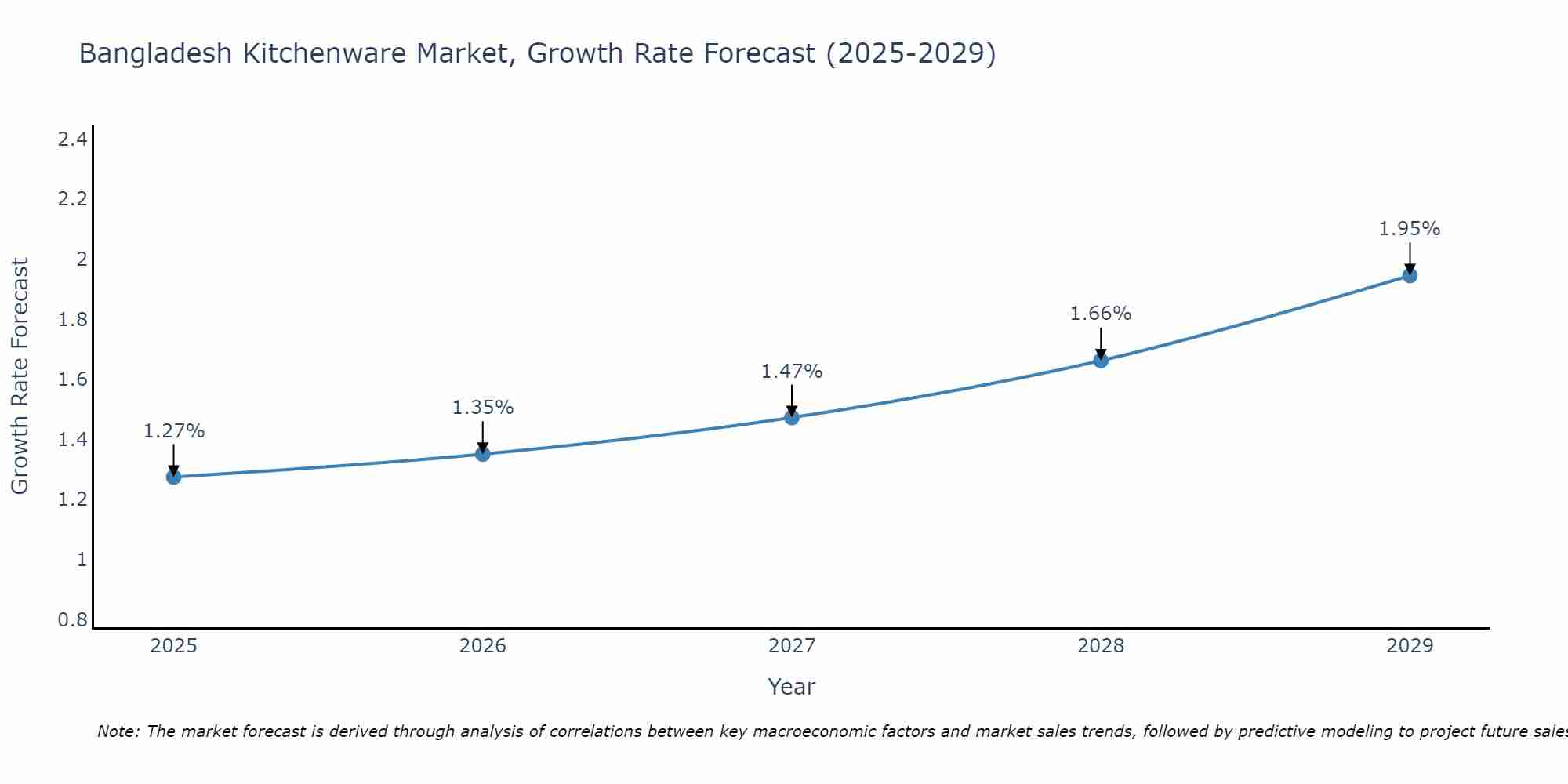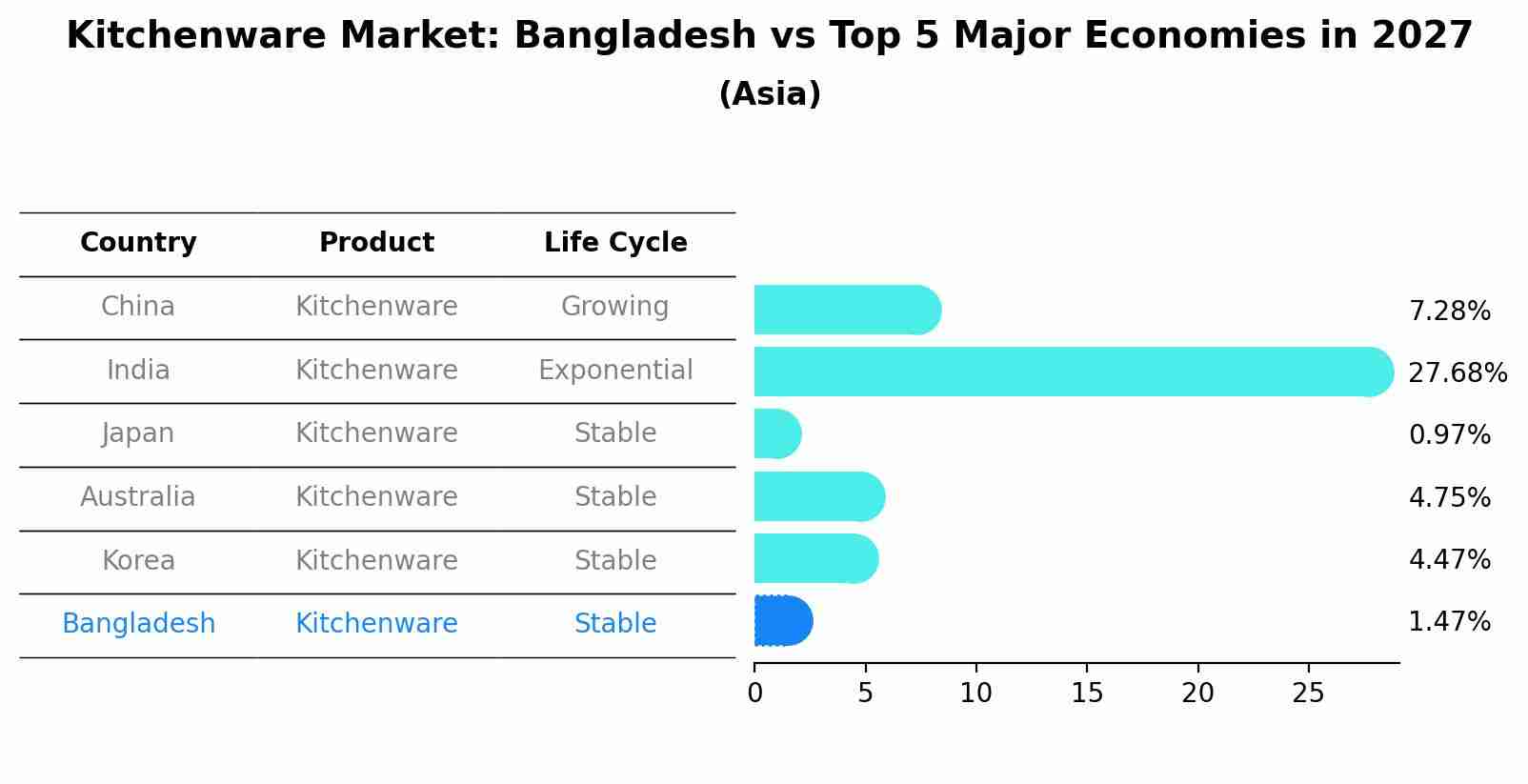Bangladesh Kitchenware Market (2025-2031) Outlook | Share, Revenue, Trends, Analysis, Industry, Growth, Companies, Value, Size & Forecast
| Product Code: ETC377072 | Publication Date: Aug 2022 | Updated Date: Jul 2025 | Product Type: Market Research Report | |
| Publisher: 6Wresearch | Author: Summon Dutta | No. of Pages: 75 | No. of Figures: 35 | No. of Tables: 20 |
Bangladesh Kitchenware Market Size Growth Rate
The Bangladesh Kitchenware Market is poised for steady growth rate improvements from 2025 to 2029. Commencing at 1.27% in 2025, growth builds up to 1.95% by 2029.

Kitchenware Market: Bangladesh vs Top 5 Major Economies in 2027 (Asia)
The Kitchenware market in Bangladesh is projected to grow at a stable growth rate of 1.47% by 2027, highlighting the country's increasing focus on advanced technologies within the Asia region, where China holds the dominant position, followed closely by India, Japan, Australia and South Korea, shaping overall regional demand.

Bangladesh Kitchenware Market Synopsis
The Bangladesh kitchenware market is experiencing steady growth driven by factors such as increasing urbanization, rising disposable income levels, and changing consumer preferences. The market offers a wide range of products including cookware, bakeware, utensils, and appliances, with a growing demand for modern and innovative kitchen tools. Local manufacturers and international brands compete in this fragmented market, with a focus on affordability and quality. Traditional kitchenware materials such as stainless steel and aluminum remain popular, although there is a growing trend towards eco-friendly and durable options like ceramic and silicone. E-commerce platforms are playing a significant role in expanding market reach and accessibility for consumers across urban and rural areas. Overall, the Bangladesh kitchenware market presents opportunities for both domestic and international players to cater to the evolving needs of consumers in this dynamic market.
Bangladesh Kitchenware Market Trends
The Bangladesh kitchenware market is experiencing a shift towards more durable and high-quality products, driven by rising consumer interest in cooking and home dining. Stainless steel and non-stick cookware are particularly popular due to their durability and ease of maintenance. Additionally, there is a growing demand for eco-friendly and sustainable kitchenware options, such as bamboo utensils and recycled glass containers, reflecting the increasing focus on environmental consciousness among consumers. The market is also witnessing a rise in the adoption of innovative kitchen gadgets and appliances that enhance convenience and efficiency in cooking. Overall, the trend in the Bangladesh kitchenware market is moving towards a combination of quality, sustainability, and functionality to meet the evolving needs and preferences of consumers.
Bangladesh Kitchenware Market Challenges
In the Bangladesh kitchenware market, several challenges are prevalent. Firstly, the market is highly fragmented with a large number of local and unorganized players, leading to intense competition and price wars. This makes it difficult for established brands to maintain market share and profitability. Secondly, the lack of standardized quality control measures and regulatory frameworks poses a challenge in ensuring product safety and consumer trust. Additionally, fluctuations in raw material prices, particularly for stainless steel and aluminum, impact the overall cost structure of kitchenware manufacturers. Lastly, limited access to modern distribution channels and the predominance of traditional retail outlets hinder market penetration and product reach, especially in rural areas. Overcoming these challenges would require strategic collaborations, investments in quality assurance, and innovative marketing approaches tailored to the local context.
Bangladesh Kitchenware Market Investment Opportunities
The Bangladesh kitchenware market presents promising investment opportunities due to the country`s growing urban population, increasing disposable income, and changing lifestyle preferences. With a rising demand for modern and innovative kitchen products, there is a need for high-quality and affordable kitchenware items such as cookware, bakeware, utensils, and small appliances. Investors can capitalize on this trend by introducing new and trendy kitchenware brands, focusing on product innovation, and expanding distribution networks to reach a wider customer base. Additionally, leveraging e-commerce platforms for sales and marketing can further enhance market penetration. Overall, investing in the Bangladesh kitchenware market offers potential for growth and profitability in a rapidly evolving consumer goods sector.
Jordan Agar Market Government Policies
In Bangladesh, the kitchenware market is influenced by various government policies aimed at promoting domestic manufacturing, ensuring product quality, and regulating imports. The government has implemented policies to support local kitchenware manufacturers through incentives, subsidies, and infrastructure development initiatives. Additionally, there are regulations in place to maintain product standards, food safety, and consumer protection. Import duties and tariffs are imposed on kitchenware imports to encourage domestic production and reduce reliance on foreign manufacturers. The government also focuses on promoting sustainable practices within the kitchenware industry to minimize environmental impact. Overall, the regulatory framework in Bangladesh`s kitchenware market aims to foster a competitive and sustainable sector while safeguarding consumer interests.
Bangladesh Kitchenware Market Future Outlook
The Bangladesh Kitchenware Market is projected to experience steady growth in the coming years, driven by factors such as increasing urbanization, rising disposable income levels, and changing consumer preferences. The market is expected to benefit from the growing demand for modern and innovative kitchenware products that offer convenience and efficiency in the kitchen. Additionally, the rising trend of home cooking and baking, fueled by the COVID-19 pandemic, is expected to further boost market growth. Manufacturers are likely to focus on product innovation, sustainability, and affordability to cater to the evolving needs of consumers. Overall, the Bangladesh Kitchenware Market presents opportunities for expansion and development, with a positive outlook for the future.
Key Highlights of the Report:
- Bangladesh Kitchenware Market Outlook
- Market Size of Bangladesh Kitchenware Market, 2024
- Forecast of Bangladesh Kitchenware Market, 2031
- Historical Data and Forecast of Bangladesh Kitchenware Revenues & Volume for the Period 2021 - 2031
- Bangladesh Kitchenware Market Trend Evolution
- Bangladesh Kitchenware Market Drivers and Challenges
- Bangladesh Kitchenware Price Trends
- Bangladesh Kitchenware Porter's Five Forces
- Bangladesh Kitchenware Industry Life Cycle
- Historical Data and Forecast of Bangladesh Kitchenware Market Revenues & Volume By Product Type for the Period 2021 - 2031
- Historical Data and Forecast of Bangladesh Kitchenware Market Revenues & Volume By Cookware for the Period 2021 - 2031
- Historical Data and Forecast of Bangladesh Kitchenware Market Revenues & Volume By Bakeware for the Period 2021 - 2031
- Historical Data and Forecast of Bangladesh Kitchenware Market Revenues & Volume By Others for the Period 2021 - 2031
- Historical Data and Forecast of Bangladesh Kitchenware Market Revenues & Volume By End User for the Period 2021 - 2031
- Historical Data and Forecast of Bangladesh Kitchenware Market Revenues & Volume By Residential Kitchen for the Period 2021 - 2031
- Historical Data and Forecast of Bangladesh Kitchenware Market Revenues & Volume By Commercial Kitchens for the Period 2021 - 2031
- Historical Data and Forecast of Bangladesh Kitchenware Market Revenues & Volume By Sales Channel for the Period 2021 - 2031
- Historical Data and Forecast of Bangladesh Kitchenware Market Revenues & Volume By Online for the Period 2021 - 2031
- Historical Data and Forecast of Bangladesh Kitchenware Market Revenues & Volume By Offline for the Period 2021 - 2031
- Bangladesh Kitchenware Import Export Trade Statistics
- Market Opportunity Assessment By Product Type
- Market Opportunity Assessment By End User
- Market Opportunity Assessment By Sales Channel
- Bangladesh Kitchenware Top Companies Market Share
- Bangladesh Kitchenware Competitive Benchmarking By Technical and Operational Parameters
- Bangladesh Kitchenware Company Profiles
- Bangladesh Kitchenware Key Strategic Recommendations
Frequently Asked Questions About the Market Study (FAQs):
- Single User License$ 1,995
- Department License$ 2,400
- Site License$ 3,120
- Global License$ 3,795
Search
Thought Leadership and Analyst Meet
Our Clients
Related Reports
- Afghanistan Apparel Market (2026-2032) | Growth, Outlook, Industry, Segmentation, Forecast, Size, Companies, Trends, Value, Share, Analysis & Revenue
- Canada Oil and Gas Market (2026-2032) | Share, Segmentation, Value, Industry, Trends, Forecast, Analysis, Size & Revenue, Growth, Competitive Landscape, Outlook, Companies
- Germany Breakfast Food Market (2026-2032) | Industry, Share, Growth, Size, Companies, Value, Analysis, Revenue, Trends, Forecast & Outlook
- Australia Briquette Market (2025-2031) | Growth, Size, Revenue, Forecast, Analysis, Trends, Value, Share, Industry & Companies
- Vietnam System Integrator Market (2025-2031) | Size, Companies, Analysis, Industry, Value, Forecast, Growth, Trends, Revenue & Share
- ASEAN and Thailand Brain Health Supplements Market (2025-2031) | Strategy, Consumer Insights, Analysis, Investment Trends, Opportunities, Growth, Size, Share, Industry, Revenue, Segments, Value, Segmentation, Supply, Forecast, Restraints, Outlook, Competition, Drivers, Trends, Demand, Pricing Analysis, Competitive, Strategic Insights, Companies, Challenges
- ASEAN Bearings Market (2025-2031) | Strategy, Consumer Insights, Analysis, Investment Trends, Opportunities, Growth, Size, Share, Industry, Revenue, Segments, Value, Segmentation, Supply, Forecast, Restraints, Outlook, Competition, Drivers, Trends, Demand, Pricing Analysis, Competitive, Strategic Insights, Companies, Challenges
- Europe Flooring Market (2025-2031) | Outlook, Share, Industry, Trends, Forecast, Companies, Revenue, Size, Analysis, Growth & Value
- Saudi Arabia Manlift Market (2025-2031) | Outlook, Size, Growth, Trends, Companies, Industry, Revenue, Value, Share, Forecast & Analysis
- Uganda Excavator, Crane, and Wheel Loaders Market (2025-2031) | Strategy, Consumer Insights, Analysis, Investment Trends, Opportunities, Growth, Size, Share, Industry, Revenue, Segments, Value, Segmentation, Supply, Forecast, Restraints, Outlook, Competition, Drivers, Trends, Demand, Pricing Analysis, Competitive, Strategic Insights, Companies, Challenges
Industry Events and Analyst Meet
Whitepaper
- Middle East & Africa Commercial Security Market Click here to view more.
- Middle East & Africa Fire Safety Systems & Equipment Market Click here to view more.
- GCC Drone Market Click here to view more.
- Middle East Lighting Fixture Market Click here to view more.
- GCC Physical & Perimeter Security Market Click here to view more.
6WResearch In News
- Doha a strategic location for EV manufacturing hub: IPA Qatar
- Demand for luxury TVs surging in the GCC, says Samsung
- Empowering Growth: The Thriving Journey of Bangladesh’s Cable Industry
- Demand for luxury TVs surging in the GCC, says Samsung
- Video call with a traditional healer? Once unthinkable, it’s now common in South Africa
- Intelligent Buildings To Smooth GCC’s Path To Net Zero


















